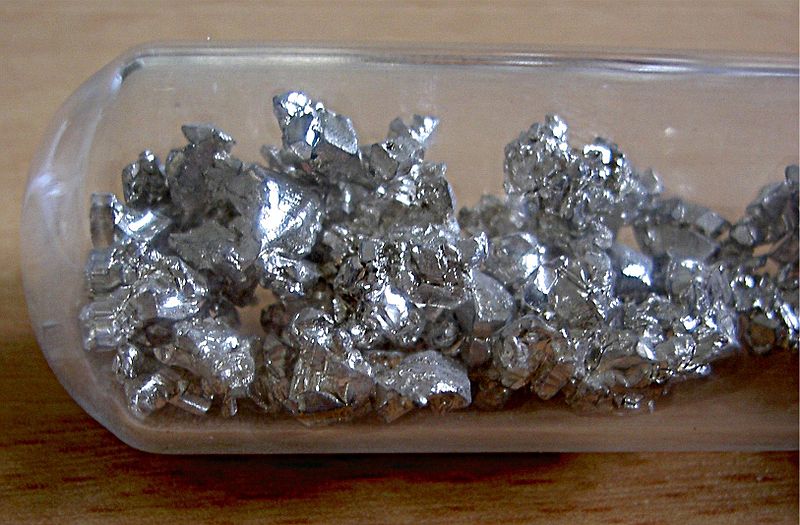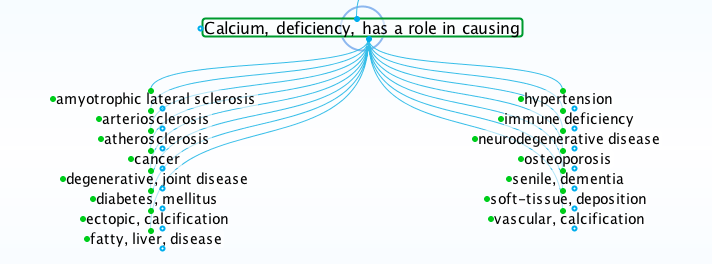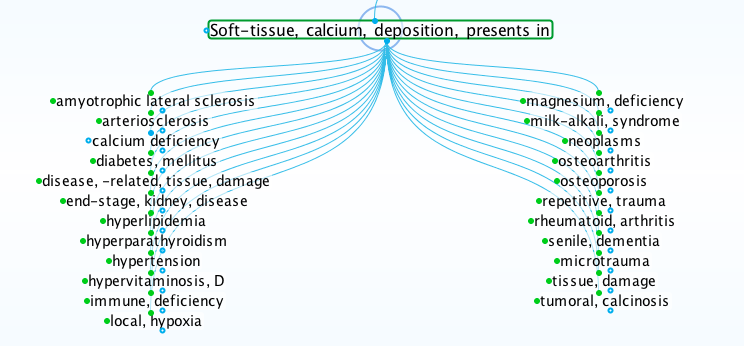Posted by Horton Tatarian, research biochemist, on 23rd May 2016
Calcium, Health, and Disease

Calcium in Health
What Requires Calcium
The chemical element, calcium, has vital roles in all body cells and tissues.
In addition to serving as a component of bone, calcium ions (electrically charged calcium atoms) are essential to the brain, heart, and every other organ. Fortunately, despite common calcium deficiencies, practically everyone has enough calcium in their system to remain among the living.

Life Sciences Database Screenshot, What requires calcium (partial list), Lifesciences.care
As with magnesium deficiency, calcium deficiency first leads to suboptimal function. Deficiencies of calcium, magnesium, and other nutrients tend to occur together due to poor dietary choices.
What Requires Adequate Calcium Intake
Optimal health requires significantly higher calcium intake than supplied by commercially prepared foods and typical Western diets. Researchers use terms such as "optimal" or "optimizing" to describe health and function far greater than mere survival.
There are clear fracture benefits demonstrated in randomized clinical trials of calcium and vitamin D supplementation. The other micronutrient needs for optimizing bone health can be easily met by a healthy diet that is high in fruits and vegetables to ensure adequate intakes for magnesium, potassium, vitamin C, vitamin K, and other potentially important nutrients. Reference

Life Sciences Database Screenshot, What requires adequate calcium intake (partial list), Lifesciences.care
Most people with Western dietary habits live in a state of calcium deficiency. Insufficient intake ("Low-calcium diet" in the following list) likely accounts for most of this deficit, but other factors can account for reduced absorption.
Sunlight and vitamin D deficiency cause suboptimal calcium absorption. Caffeine, impaired intestinal function, added dietary sugar and fructose, and reduced stomach acid (hypochlorhydria) also reduce the intestinal absorption of calcium.
Low stomach acid is common in the elderly. Drugs that reduce stomach acid secretion cause hypochlorhydria (low stomach acid). Likewise, medicines and calcium supplements that neutralize stomach acid are counterproductive.

Life Sciences Database Screenshot, What reduces calcium absorption (growing list), Lifesciences.care
The Body's Two Calcium Sources
The body regularly draws from two calcium sources: bone and diet. The body's store of calcium is in bone tissue.
When dietary intake of calcium is high, extra calcium is stored in the bones or excreted when calcium stores are sufficient. When calcium intake is low, the body draws calcium from bones to satisfy the essential functions of other organs and tissues.

Life Sciences Database Screenshot, What supplies calcium (to the body), Lifesciences.care
A healthful diet and dietary supplementation provide adequate amounts of calcium, magnesium, phosphorous, potassium, protein, vitamin C, D, and K, plus other nutrients in fruits and vegetables.

Life Sciences Database Screenshot, Optimal bone health requires, Lifesciences.care
A plant-based diet high in fruits and vegetables supplies the calcium and other nutrients needed for optimal bone health. (A plant-based diet supplies dairy cows and goats ample calcium, well beyond their needs.)
While dairy products are a traditional part of the human diet, modern commercial dairy products carry increased risk of disease.
Calcium in Disease
Calcium Deficiency
As with magnesium deficiency, calcium deficiency may be as prevalent as all of the degenerative diseases associated with the Western diet, combined.
In the screenshot below, "ectopic calcification" refers to unwanted calcium deposits, as in bone spurs, around arthritic joints, or in arteries. "Soft-tissue deposition" is similar but includes diffuse deposits in tissues or within cells, as occurs in senile dementia and other neurodegenerative diseases. "Vascular calcification" refers to the laying down of calcium within blood vessel walls, as takes place in arteriosclerosis and atherosclerosis.

Life Sciences Database Screenshot, Calcium deficiency has a role in causing (partial list), Lifesciences.care
The question then arises: Why do calcium deposits form in calcium deficiency when excess calcium appears to be the problem?
The Calcium Paradox
Researchers use the term "calcium paradox" in connection with unexpected consequences of calcium deficiency, such as calcium deposits around joints, within blood vessels, or in the brain even when calcium is in short supply.
Although several factors contribute to the paradox (see the screenshot below), calcium deficiency alone is sufficient to cause the problem. Calcium deficiency stimulates parathyroid hormone production, which mobilizes calcium from bone and leads to excess calcium flow into other tissues.
Calcium deficiency is readily connected with osteoporosis, which is a decrease of bone calcium content. Less well known is the calcium outflow from bone that occurs to prevent decrease of blood calcium in calcium deficiency caused by the parathyroid hormone, with consequent calcium overflow into soft tissues and the intracellular compartment. Reference
The calcium paradox also extends to the loss calcium from the bone (osteoporosis) while it accumulates in blood vessels instead (arteriosclerosis). Osteoporosis and vascular calcification tend to occur together and to similar degrees.
Furthermore, developed calcium deposits in diseased blood vessels look like bone tissue. In tissue culture, the muscle cells of arteries have the ability to function and look like bone cells.
The capacity of the vasculature to produce mineral in culture and to produce de novo, vascularized, trabecular bone and cartilage tissue, even in patients with osteoporosis, should intrigue investigators in tissue engineering and regenerative biology. Reference
In health, several regulatory mechanisms prevent the innate ability of blood vessel cells to function like bone cells. The disruption or loss of these mechanisms can lead to vascular calcification (calcium deposits in blood vessels).
The following screenshot lists four nutritional deficiencies that have a role in vascular calcification: the lack of calcium, magnesium, essential fatty acids, and vitamin K.

Life Sciences Database Screenshot, What has a role in causing vascular calcification, Lifesciences.care
Soft-Tissue Calcium Deposits
While calcium deposition in arteries is a feature of arteriosclerosis, calcium deposits also occur in other soft tissues (living tissues other than bone and teeth). Conditions associated with calcium deposition appear below:

Life Sciences Database Screenshot, Soft-tissue calcium deposition presents in, Lifesciences.care
Assuring Calcium Sufficiency
Calcium Supplementation
Recommended calcium minerals for supplementation include:
- Calcium citrate
- Calcium malate (best for supporting energy levels)
- Microcrystalline hydroxyapatite concentrate (derived from whole bovine bone)
Related Product Category
A Calcium-Rich Diet
In addition to dark green leafy vegetables, good calcium (and magnesium) sources include nuts, seeds, beans, lentils, peanuts, peanut butter, quinoa, sprouted grains and seeds, avocado, bananas, dried fruit, raw milk products, wild Alaskan salmon, and sardines.
Related Articles
Consume Non-Toxic Calcium
Eat Foods High In Electrons
About Horton Tatarian

I’m a biochemist who examines scientific findings on health and disease. My degree in biochemistry is from U.C. Berkeley. UCLA School of Medicine granted an M.D. degree in 1974. Since then, independent research prepared me to advise clients on natural ways of self-care.

